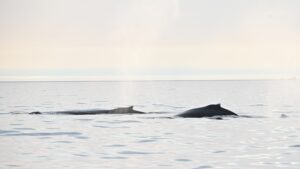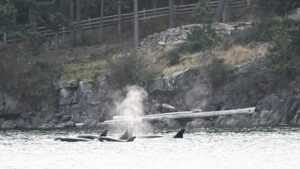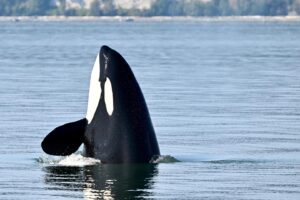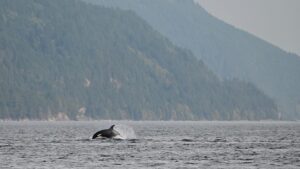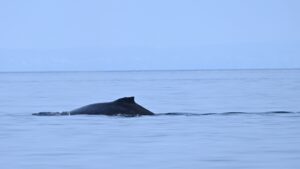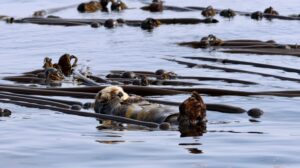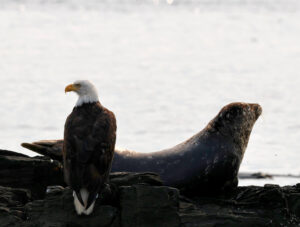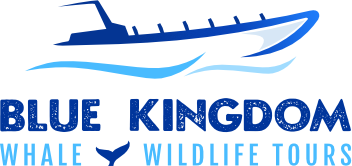September?! How did THAT happen? As I reflect back on another week of whales, wildlife, foggy and smoky weather mixed in with some sun, and now the shortening days (getting dark just after 8pm) it’s sinking in that fall is on our heels. The Salish Sea continues to be bountiful in wildlife and because its resources support the whales we find here, we have continued to have whale encounters on each of our tours, mainly Bigg’s killer whales (marine-mammal eaters), some humpbacks, and a couple Minke whales.
Bigg’s killer whale families that were encountered on our tours this week were: the T49As (5), T63 & T65 (2), T69E, T75Bs (5), T100s (3), T124Ds (4), and the T137s (4) making for a total of 24 individuals. Certain family groups seem to have preferences for where they decide to hunt and spend their time, and the T137s are a group of killer whales that spend ample time in Puget Sound. During this last week, they were often too far south (like, near Olympia, south!) to visit with, but when they pushed north into Saratoga Passage or into Port Susan, we introduced guests to this foursome. On multiple occasions they were actively hunting which made for surface active behavior including breaching, tail slapping, and even a dorsal slap from T137A Jack! Imagine a male killer whale with a 5-6′ dorsal turning on his side so fast that the dorsal makes a slapping sound at the surface. He was all fired up about dinner, and honestly, who can’t relate to that? 🙂
The T75Bs have been making circuits through the Gulf Islands, occasionally poking out into the Strait of Georgia, and then pushing south to circle some of the Outer Islands, Spieden Island, and San Juan Island, too. They were another group of whales that were doing quite a bit of hunting, and as mom has a new little one in tow, she needs to eat to keep up with her own metabolic needs while producing enough milk for the calf, too. It’s still the cutest sight to see the little orange-hued babe with her higher surfacings, excited flailing, and on a couple encounters, her little tail waving in the air.
We continued to encounter the occasional humpback whale this week, as well. BCZ0345 “Victory” is really enjoying some of the “victory laps” she keeps making as she peruses banks off of the south end of Lopez and San Juan Island. On one encounters, she had another humpback whale with her, and the two were engaging in lunge feeding behavior. This occurs when humpbacks find bait balls–a mass or corralled forage fish–and lunge to the surface with their mouths open, hoping to get as much as they can on that pass. This other humpback had distinct markings on the underside of their tail, but I could not come up with a match in the field. I turned my photos over to happywhale.com and the results surprised me! This whale was first recorded this year back in early February near Baja California Sur in Mexico! Myself and one other naturalist in the central Salish Sea are the only two individuals who have taken photos and uploaded this whale in our area, so no wonder I was having such difficulty figuring out who our mystery humpback was! In due time, this whale will wind up with a nickname, but for right now they are known by their happywhale designation of HW-MN0524500. There are several things that are awesome about encounters such as these, but certainly helping to fill in data gaps by encountering these individuals and following up with submissions to researchers is at the top.
Minke whales continue to cruise around Salmon Bank, Middle Bank, and Hein Bank and were seen on several of our small group, all day tours this week on “Wake.” As very shy whales, earning their nicknames “Slinky Minke,” it might not be too long until they begin to depart the Salish Sea to make their migration to lower latitudes. Those breeding areas are still a mystery to scientists, but we do know that they make them based on their exit from our areas (and other higher latitude areas), being counted in the baleen whale migration census that takes place off of Point Vincente in California each year.
A few other notable sightings: the “spa day” sea otter near Cattle Pass is still occupying that spot, for the most part, and we’re noticing some LARGE male Steller sea lions beginning to make their way back into the Salish Sea. Yet another marker for the changing season that is about to occur. In all, it was a great week, and as always, we are looking forward to seeing what the next week of wildlife sightings is going to bring us.
